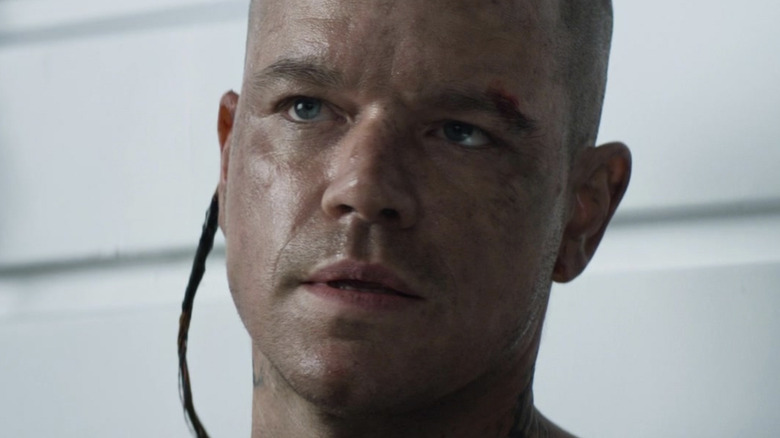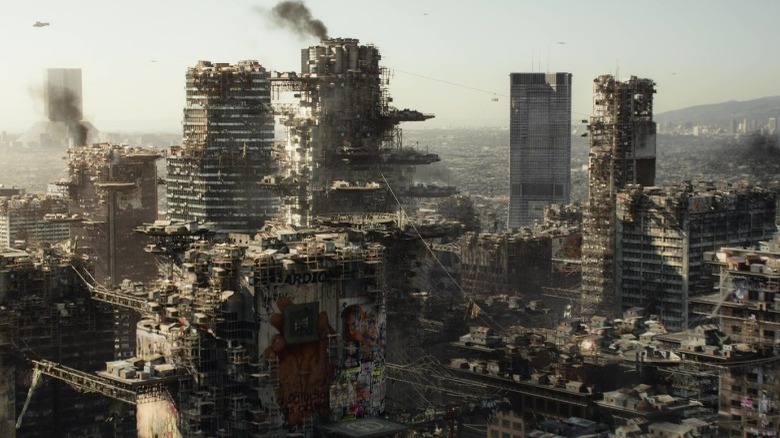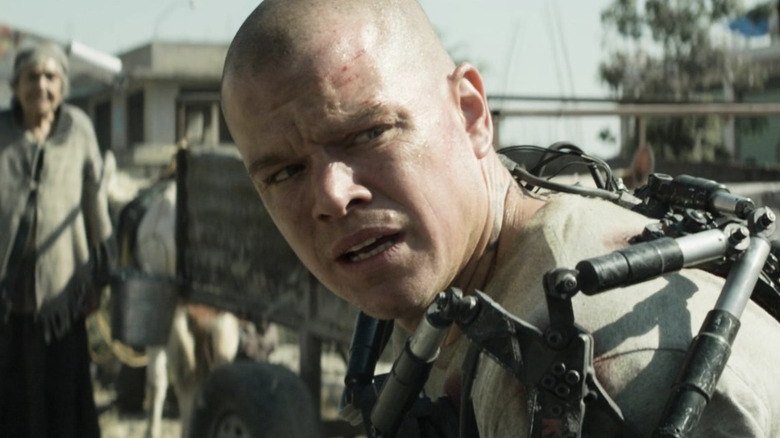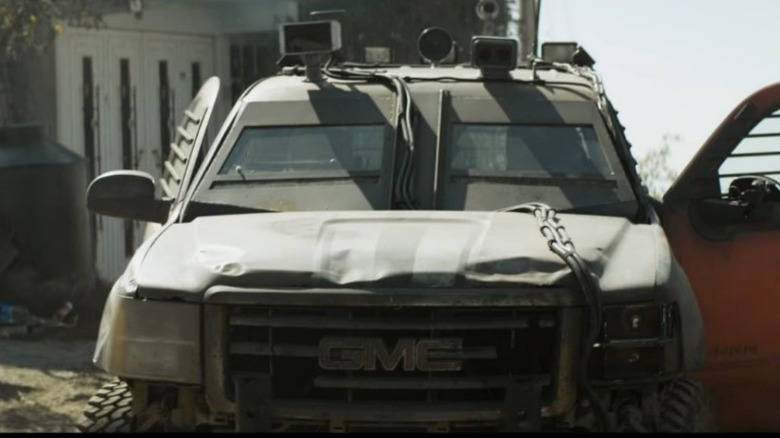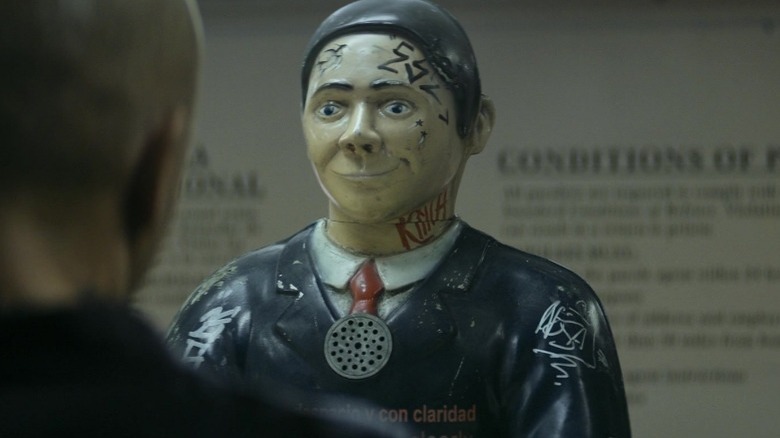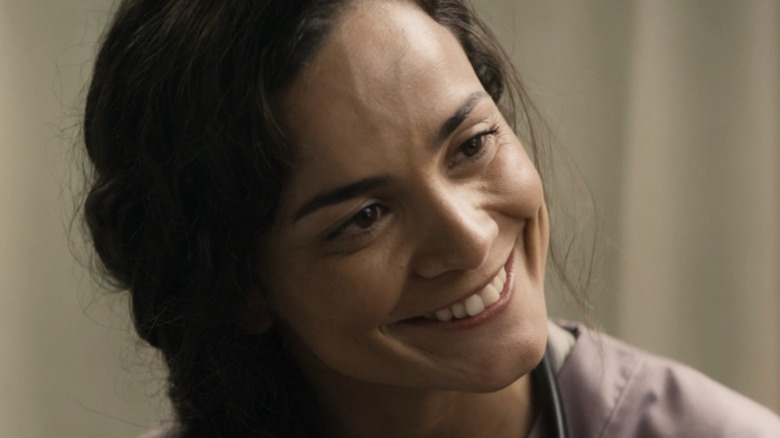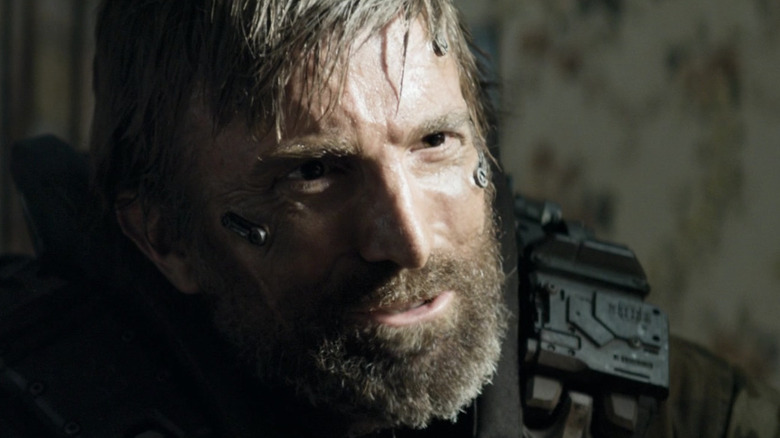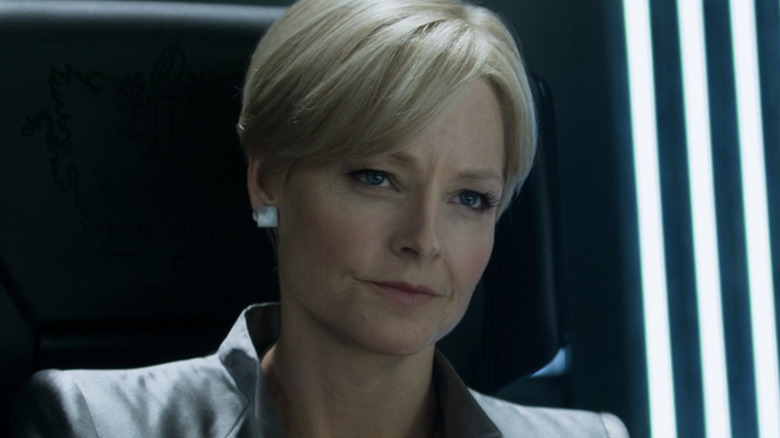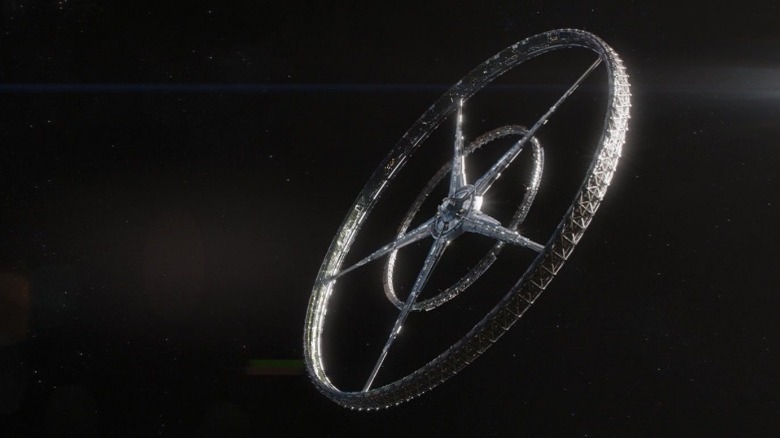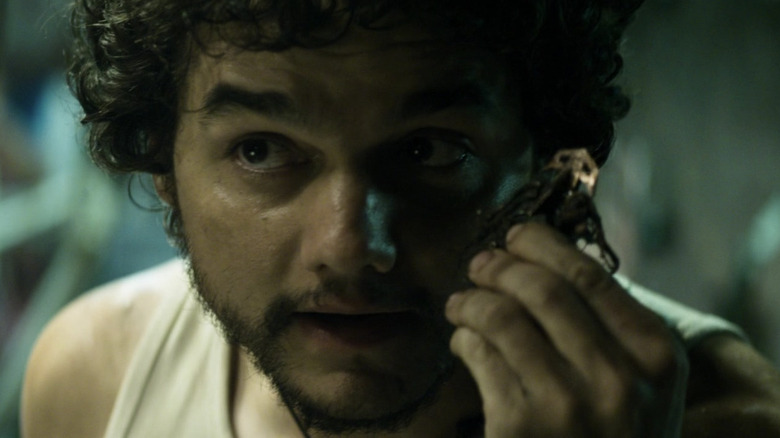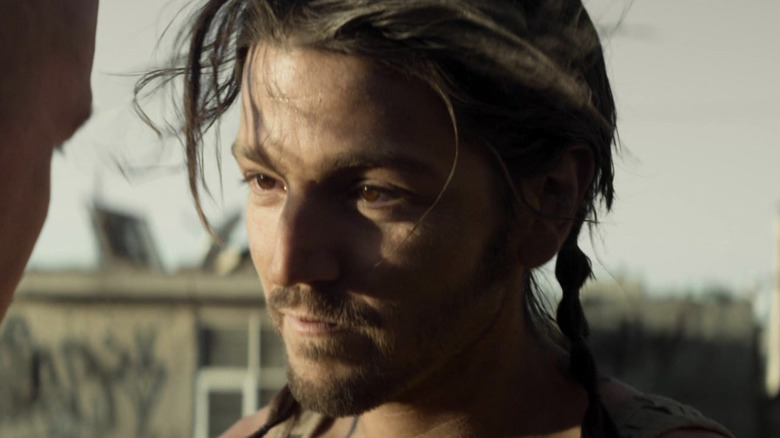11 Elysium Facts That Only Hardcore Fans Of The Sci-Fi Thriller Would Know
Director Neill Blomkamp made a splash with his feature debut "District 9" in 2009 and since then, fans have eagerly awaited a sequel. Thankfully, Blomkamp tweeted in 2021 that he was writing the screenplay along with his collaborators Sharlto Copley and Terri Tatchell and as of 2022, the sequel remains a priority on the director's to-do list. So, while we wait for "District 10" to get made, sci-fi fans can bide their time with "District 9" and other films by Blomkamp.
Blomkamp's second feature, "Elysium," had a much bigger budget than "District 9" (per The Hollywood Reporter), and it was the director's first foray into blockbuster territory. Yet many fans may not realize what went on behind the scenes of this film to create Blomkamp's vivid and nightmarish vision of the future. You might be surprised to find out who was almost cast as the lead instead of Matt Damon or the unexpected location where many of the Earth scenes were shot. Here are the most memorable facts about the production of "Elysium," which only the most hardcore fans will know.
An alternate opening could have changed the whole movie
"Elysium" opens with a brief introduction to the state of the world: images of the slums on Earth and paradise in space are overlaid with text explaining that Earth has gotten so overpopulated and over-polluted that the rich have fled to the Elysium space station. It's an effective and balanced opening, as it neither dumps a bunch of exposition onto viewers nor plunges them blindly into the story without knowing anything at all. It gives audiences just enough to understand this world on screen.
However, the movie wasn't always this way. Director Neill Blomkamp considered some alternate openings that might have taken the movie in a different direction. During a Q&A for the film in Los Angeles in 2013, Blomkamp said that he initially wanted to use a cold opening and trust viewers to piece everything together on the fly: "I like films that just put you there and you have to deal with it" (per MovieWeb).
On the flip side, the director also considered spending longer on the intro to establish the world in more detail and give audiences more exposition. He even shot portions of this longer opening.
Eventually, Blomkamp settled on an approach that fell somewhere in the middle, which is what we see in the final version of the film. It has the best of both worlds, since it offers enough information to bring moviegoers quickly into this world without having to guess what's happening, while also avoiding the trap of bogging the movie down with too much exposition. This way, viewers get the chance to discover the world of "Elysium" for themselves.
The director almost cast somebody else in the lead role
Originally, Neill Blomkamp wasn't planning to cast a high-profile Hollywood star in the role of Max. In its earliest iteration, "Elysium" was an independent project with a smaller budget, like "District 9."
Blomkamp told The Associated Press that he had written a low budget version of the movie, which was "a very different film" and for that, he wanted to "try to find someone very unusual and weird and unexpected" for the lead. In fact, he initially pictured someone closer to home for the character of Max.
According to Wired, the director's first choice was Ninja, the rapper from the South African music group Die Antwoord. Ninja was flattered since "District 9" is his favorite movie, but he ultimately declined. The rapper was proud of his South African roots and didn't want to make his big-screen debut playing an American character with an American accent.
So, Blomkamp set his sights on another rapper: Eminem. However, Eminem would only agree to take the role if he could film in his hometown of Detroit. This was a dealbreaker for Blomkamp, who had a very specific vision of where he wanted to film.
The director then pivoted to rewrite "Elysium" as a big budget blockbuster, so he had to cast a more well-known actor. "Matt [Damon] was my favorite on the list," he told The Associated Press. He explained to The Telegraph that while he was initially apprehensive of working with the big egos of A-list stars, both Damon and Jodie Foster surprised him by doing what he asked and making the film run smoothly and easily.
The vehicles in Elysium bear the names of real-life car brands
To anchor his dystopian future in reality, director Neill Blomkamp planted the names of real car brands on some of the vehicles in "Elysium." For instance, the uber-wealthy John Carlyle (William Fitchner) drives a flying Bugatti, which is exactly the sort of car that the uber wealthy drive today. Meanwhile, Max's exo-suit sports a Kawasaki logo. You'll also notice that Max and Julio (Diego Luna) drive an armored Nissan GT-R.
Car experts such as Jalopnik placed the car's age around 140 years old, since "Elysium" is set in 2154 and the model looks pretty similar to present day Nissans. Seeing characters from the future still using a vehicle this old would be comparable to seeing somebody in 2013 driving a 1873 Siegfried Marcus internal combustion engine car (per Jalopnik).
Publications like Autoblog accused Blomkamp of using product placements with these car brands, but that couldn't be further from the truth. He actually chose these logos because they made sense for the story. "Someone living up [in Elysium] would have a Bulgari digital iPhone watch and fly in a Bugatti," the director explained to NBC Chicago.
According to NBC Chicago, Blomkamp received no compensation for using these big brand names. In fact, he had to beg companies for permission precisely because of his desire to create a realistic dystopia, which isn't exactly the same as using product placement in a movie starring Matt Damon and Jodie Foster.
The film has plenty of real life inspiration
"Elysium" might not have even existed had director Neill Blomkamp not gotten the right inspiration at the right time. After "District 9" came out, Blomkamp knew that he wanted to follow up his feature film debut with a sci-fi movie about class divides. But according to Wired, the film didn't take shape in his head until he saw a National Geographic illustration of NASA's proposed Stanford Torus space habitat, and that's when he had the idea for the Elysium space station.
That illustration was created by Syd Mead, who contributed to sci-fi classics like "Blade Runner" and "Aliens," both of which Blomkamp has also cited as "the films that got me most into wanting to make films" (per The Chicago Tribune). In a full circle moment, Blomkamp hired the then 80-year-old Mead to design the space station for "Elysium" (per Vulture).
The space station isn't the only part of the film that was inspired by something from real life. According to the interview with Wired, the disturbing scene where Max gets brain surgery drew from Blomkamp's personal experiences of losing his stepfather to brain cancer. The director told The Guardian that when he was crafting the scene with Max's robotic parole officer, he drew on his frustration working with his bank's automated phone line. He also hinted that the work accident that gives Max lethal radiation poisoning is all too similar to real-life workplace abuse in developing nations.
Blomkamp doesn't want to put message above entertainment in Elysium
Neill Blomkamp is no stranger to making socially-conscious movies. But while "Elysium" doesn't shy away from political themes such as class divides, immigration, and health insurance, the director has made it clear that he wants his film to be entertainment first and foremost rather than a call to action.
Blomkamp didn't intend for "Elysium" to be a "message" movie. And even if he had, he doubts it would have changed people's minds. He explained during a 2013 Q&A of the film, "If I wanted to make something that actually made a difference ... I would make a documentary" (per Entertainment Weekly).
Certainly, Blomkamp does try to make social commentary in his films. In fact, he told The Guardian that he can't imagine creating art without some kind of social or political observation. However, he says he probably wouldn't have been passionate enough to make this project if it didn't have action or robots or explosions — all the things he finds entertaining. "For me to make a film without including any of those elements is just kind of boring to me," he admitted to Entertainment Weekly. Luckily for sci-fi fans, "Elysium" has a perfect mix of political themes and explosions.
Kruger is based on real South African soldiers
When creating the villain for "Elysium," Neill Blomkamp had something specific in mind. The character Kruger (Sharlto Copley) is actually based on a South African military group known as 32 Battalion. As Copley explained to Flicks, the 32 Battalion formed in Africa during the early 1980s to target anyone that was suspected of being funded by or influenced by communist nations. It was supported by both Britain and the United States and was notorious for its ruthless efficiency.
Even after the unit was disbanded, governments and private clients have still continued to hire former members as mercenaries and hit men, according to Vice. In "Elysium," Secretary Delacourt (Jodie Foster) recruits Kruger with exactly this purpose in mind.
According to Copley, these men were willing to go deep undercover and were not afraid to get their hands dirty. "They would just go and live in the bush for three months and not come out, and live off the land," he told Digital Spy. Copley added, "It was a very different type of soldier from what you have now, [where soldiers rely] so much more on technology."
Copley told Flicks that these soldiers were often used as pawns by politicians — much like how Delacourt takes advantage of Kruger and tries to dispose of him when he's no longer useful. The actor leaned into this real-life inspiration when approaching Kruger's character, as he felt that Kruger's frustration at being a pawn was important to humanize the character.
The villains are not pure evil
"Elysium" has two antagonists: the ambitious Secretary Delacourt (Jodie Foster) and her unpredictable mercenary Kruger. While they are both undeniably the villains of the story, they aren't exactly evil, and both have more layers to them than meets the eye.
During a Q&A for the film's trailer release in 2013, producer Simon Kinberg pointed out that the first time we see Secretary Delacourt, she is at home with her family; this is not how villains are typically introduced (per ComingSoon.net). He added, "She's got grandkids and kids around. She wants them to live their life in a very nice suburb and genuinely believes she needs to protect them."
Meanwhile, Kruger may be a killer, but he is technically just doing his job. In the same Q&A, Sharlto Copley noted that his character is simply a soldier following orders, though he's not always happy with his orders (per ComingSoon.net). Kruger feels like he ought to be on Elysium instead of working in the slums. What's more, Kruger knows Delacourt is using him and is secretly disgusted by him. This actually gives him something in common with Max, who is treated the same way by Carlyle and everyone else from Elysium.
Copley shared in an interview with The NZ Herald that he felt obligated to portray Kruger with at least a hint of empathy. "When you are playing a villain," he said, "I think you have to find some justification for the character's behavior, so you can play him convincingly."
This sci-fi film doesn't always stick to science
Just because "Elysium" is science fiction, that doesn't mean it's always scientifically accurate. Even Blomkamp himself admitted during a Q&A of the film, "Proper science was sort of thrown out the window in favor of metaphor or story or plot" (per Entertainment Weekly). For example, he pointed out that a space station made from heavy rock like marble and slate probably wouldn't work in real life but it works for the figurative image of "Bel Air in space."
According to Space.com, building Elysium would've required a phenomenal amount of energy to haul that much mass into orbit. Our current chemical propulsion technology would not be sufficient for the job, explained Mark Uhran, former director of NASA's International Space Station Division. Even if we could somehow build the station, there would still be other complications to deal with such as finding a way to protect Elysium's residents from radiation (per Dice). Based on current scientific knowledge, the simplest way to achieve this would be with a massive ring of lead and other minerals encircling Elysium, which is not shown in the movie.
Meanwhile, Max's exo-suit has a real-life basis. Devices such as the Human Universal Technology Load Carrier (or HULC) already exist, points out The Washington Post. However, unlike the HULC, Max's exo-suit is drilled into his skeleton, which some scientists have pointed out makes no sense. The purpose of the exo-suit is to relieve some of the strain on Max's muscles and bones, but attaching the suit to Max's skeleton would only transfer some of the weight right back to his body.
Blomkamp went to great lengths to make his world believable
Even if the world of "Elysium" isn't always scientifically plausible, Neill Blomkamp and his team went out of their way to make the world seem realistic. Visual effects supervisor Peter Muyzers told FXGuide that Blomkamp consulted with NASA early in the process to find out if they thought that a space station like Elysium might be possible at some point in the distant future. NASA shared that they had explored the concept as early as the 1970s.
Muyzers noted that Blomkamp instructed his VFX team not to create anything for the world of "Elysium" without having some kind of real visual reference. Muyzers recalled to FXGuide that the director told him, "Don't just throw stuff in there to make this stuff up." Blomkamp would even reject certain designs on the basis that they looked too much like they came from a science fiction movie.
Ultimately, Blomkamp's process boils down to a simple principle: The vision of the future has to be grounded in reality. As Mark Salisbury's "Elysium: The Art of the Film" notes, if the concept art or VFX designers went too much into the realm of "gee whiz" sci-fi fantasy, they had to bring their vision back down to Earth (per Gizmodo).
Blomkamp isn't too confident about humanity's future
In "Elysium," the future looks pretty bleak. The Earth is unlivable, poverty is everywhere, and anyone who dares to hope for a better future gets shot out of the sky. But surely Neill Blomkamp just envisioned this nightmare because it would make a good story. He doesn't really think the world might look like that in 2154, right?
Ehhh ... the director isn't all that optimistic. If he had to bet on the state of the human race 150 years later, he wouldn't be surprised if it resembled the world of his film. Blomkamp told The Guardian that unless people make proper use of technological innovation and artificial intelligence, humanity will take one of two paths: "it'll either be a singularity discussion or ... a Malthusian catastrophe."
When speaking with The Guardian, Blomkamp argued that the self-serving behavior seen in the residents of Elysium — as well as many people in real life — stems from a primal survival instinct. In prehistoric times, the urge to stockpile resources (and refuse to share them) kept humanity alive. Now that we live in a complex civilization, said Blomkamp, this instinct manifests itself in war, xenophobia, and economic inequality, which is ultimately detrimental to humankind.
Blomkamp put it bluntly to The Telegraph by noting that "Elysium" isn't a vision of what will happen in 140 years because this movie "isn't science fiction. This is today. This is now."
The Earth scenes were filmed at a garbage dump
Watching the scenes from "Elysium" set on Earth, you may assume that the wasteland Max calls home was built on a soundstage. However, hardcore sci-fi fans will know that Blomkamp went the extra mile to make his dystopian world look like a dump. That is, he went to an actual dump.
The director wanted to capture the grittiness of slums, and he realized that the best way to capture that authentically was to shoot in a giant landfill in Mexico City that was roughly the size of West Hollywood (per Yahoo!). The filmmakers ultimately spent two weeks in this unpleasant location.
According to The Hollywood Reporter, the film crew soon discovered that dehydrated sewage was getting kicked up in dust clouds. Blomkamp admitted to Wired that he had started to have his doubts about his choice of filming location. "But you just have to wear your respirator and do it," he said.
Matt Damon told Playboy (per Geek Tyrant) that the idea of shooting action scenes in the landfill was a powerful one both visually and narratively, so "everybody bought in knowing it would be tough but also knowing we would be happy we did it." So, kudos to Blomkamp and his crew for their unwavering commitment to make the futuristic world of "Elysium" as realistic as possible.
